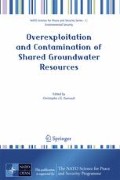It is now widely accepted that groundwater, though not as visible as surface water, is ubiquitous in the global landmass, is contained in the pore spaces of rock formations (aquifers), and its science, hydrogeology, has rapidly developed over the last 35 years. This science has contributed to the well-being and development of the human population in all parts of the globe (Burke and Moench, 2000). While aquifer systems, due to their partial isolation from surface impacts, on the whole contain excellent quality water, there has been poor resource management because “economic externalities” have been ignored. In many countries, aquifers have been fully evaluated and extensively used for municipal and oher demands, as a common good. Aquifer resources represent a substantial hidden global capital, which if abused, leads to future economic costs and environmental-social conflicts. As a result, the beneficial use of groundwater should be more particularly subjected to socio-economic, institutional, legal, cultural, ethical and policy considerations than surface water. Its national sustainable management seems to be hampered by weak social and institutional capacity, and poor legal and policy frameworks. In a transboundary context, this can be even further amplified because of contrasting levels of knowledge, capacities and institutional frameworks on either side of many international boundaries. UNESCO and its partners have established a global programme to address the long-term sustainability for groundwater resources, through a series of actions, including ISARM and PCCP. In this chapter, which is an overview designed to provide the NATO ASI with the necessary background, these actions, and the progress achieved over the past decade will be described so that participants can gain the necessary background to take the agenda forward. Some lessons learned from the inventory process of the Americas are presented, followed by a review of the linkage between transboundary aquifers and globalization, and a presentation of groundwater dependent ecosystems and governance issues. The chapter concludes with an outlook of the UNESCO programme on transboundary water resources encompassed in two very successful initiatives, the PCCP and ISARM.
Access this chapter
Tax calculation will be finalised at checkout
Purchases are for personal use only
Preview
Unable to display preview. Download preview PDF.
Author information
Authors and Affiliations
Editor information
Editors and Affiliations
Rights and permissions
Copyright information
© 2008 Springer Science + Business Media B.V
About this paper
Cite this paper
Puri, S., Aureli, A., Stephan, R.M. (2008). Shared Groundwater Resources: Global Significance for Social and Environmental Sustainability. In: Darnault, C.J.G. (eds) Overexploitation and Contamination of Shared Groundwater Resources. NATO Science for Peace and Security Series C: Environmental Security. Springer, Dordrecht. https://doi.org/10.1007/978-1-4020-6985-7_1
Download citation
DOI: https://doi.org/10.1007/978-1-4020-6985-7_1
Publisher Name: Springer, Dordrecht
Print ISBN: 978-1-4020-6983-3
Online ISBN: 978-1-4020-6985-7
eBook Packages: Earth and Environmental ScienceEarth and Environmental Science (R0)

